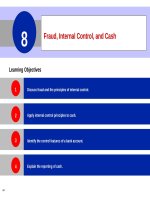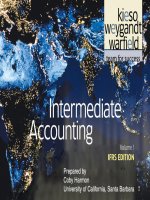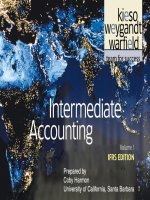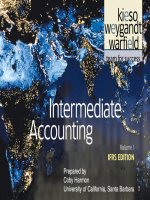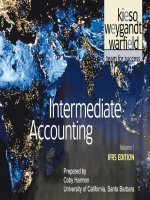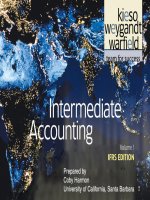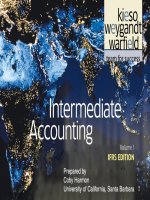Intermediate accounting volum 1 IFRS edition chapter 08
Bạn đang xem bản rút gọn của tài liệu. Xem và tải ngay bản đầy đủ của tài liệu tại đây (3.46 MB, 59 trang )
8-1
CHAPTER
8
VALUATION OF INVENTORIES:
COST-BASIS APPROACH
Intermediate Accounting
IFRS Edition
Kieso, Weygandt, and Warfield
8-2
A
Learning
Learning Objectives
Objectives
1.
Identify major classifications of inventory.
2.
Distinguish between perpetual and periodic inventory
systems.
3.
Identify the effects of inventory errors on the financial
statements.
8-3
4.
Understand the items to include as inventory cost.
5.
Describe and compare the methods used to price
inventories.
Valuation
Valuation of
of Inventories:
Inventories:
Cost-Basis
Cost-Basis Approach
Approach
Inventory Issues
Physical Goods
Included in
Inventory
Cost Included in
Inventory
Classification
Goods in transit
Product costs
Cost flow
Consigned goods
Period costs
Control
Special sales
agreements
Purchase
discounts
Basic inventory
valuation
8-4
Inventory errors
Cost Flow
Assumptions
Specific
identification
Average cost
FIFO
Summary analysis
Inventory
Inventory Issues
Issues
Classification
Inventories are:
items held for sale, or
goods to be used in the production of goods to be sold.
Businesses with Inventory
Merchandiser
8-5
or
Manufacturer
LO 1 Identify major classifications of inventory.
Inventory
Inventory Issues
Issues
Classification
Illustration 8-1
One inventory
account.
Purchase goods
in form ready for
sale.
8-6
LO 1 Identify major classifications of inventory.
Inventory
Inventory Issues
Issues
Classification
Three accounts
8-7
•
Raw materials
•
Work in process
•
Finished goods
LO 1
Illustration 8-1
Inventory
Inventory Issues
Issues
Inventory Cost Flow
8-8
Illustration 8-2
LO 1 Identify major classifications of inventory.
Inventory
Inventory Issues
Issues
Inventory Cost Flow
Illustration 8-3
Companies use one of two types of systems for maintaining
inventory records — perpetual system or periodic system.
8-9
LO 1 Identify major classifications of inventory.
Inventory
Inventory Cost
Cost Flow
Flow
Perpetual System
1. Purchases of merchandise are debited to Inventory.
2. Freight-in is debited to Inventory. Purchase returns and
allowances and purchase discounts are credited to Inventory.
3. Cost of goods sold is debited and Inventory is credited for each
sale.
4. Subsidiary records show quantity and cost of each type of
inventory on hand.
The perpetual inventory system provides a continuous
record of Inventory and Cost of Goods Sold.
8-10
LO 2 Distinguish between perpetual and periodic inventory systems.
Inventory
Inventory Cost
Cost Flow
Flow
Periodic System
1. Purchases of merchandise are debited to Purchases.
2. Ending Inventory determined by physical count.
3. Calculation of Cost of Goods Sold:
Beginning inventory
$ 100,000
Purchases, net
800,000
8-11
Goods
available for sale
LO 2 Distinguish between perpetual and periodic inventory systems.
Inventory
Inventory Cost
Cost Flow
Flow
Illustration: Fesmire Company had the following transactions
during the current year.
Record these transactions using the Perpetual and Periodic
systems.
8-12
LO 2 Distinguish between perpetual and periodic inventory systems.
Inventory
Inventory Cost
Cost Flow
Flow
Illustration:
8-13
Illustration 8-4
LO 2 Distinguish between perpetual and periodic inventory systems.
Inventory
Inventory Cost
Cost Flow
Flow
Illustration: Assume that at the end of the reporting period, the
perpetual inventory account reported an inventory balance of
$4,000. However, a physical count indicates inventory of
$3,800 is actually on hand. The entry to record the necessary
write-down is as follows.
Inventory Over and Short
Inventory
200
200
Note: Inventory Over and Short adjusts Cost of Goods Sold. In practice, companies
sometimes report Inventory Over and Short in the “Other income and expense” section
of the income statement.
8-14
LO 2 Distinguish between perpetual and periodic inventory systems.
Inventory
Inventory Issues
Issues
Inventory Control
All companies need periodic verification of the inventory
records by actual count, weight, or measurement, with the
counts compared with the detailed inventory records.
Companies should take the physical inventory near the
end of their fiscal year, to properly report inventory
quantities in their annual accounting reports.
8-15
LO 2 Distinguish between perpetual and periodic inventory systems.
Inventory
Inventory Issues
Issues
Basic Issues in Inventory Valuation
Companies must allocate the cost of all the goods available
for sale (or use) between the goods that were sold or used
and those that are still on hand.
Illustration 8-5
8-16
LO 2 Distinguish between perpetual and periodic inventory systems.
Basic
Basic Issues
Issues in
in Inventory
Inventory Valuation
Valuation
Valuation requires determining
The physical goods (goods on hand, goods in transit,
consigned goods, special sales agreements).
The costs to include (product vs. period costs).
The cost flow assumption (specific Identification,
average cost, FIFO, retail, etc.).
8-17
LO 2 Distinguish between perpetual and periodic inventory systems.
Physical
Physical Goods
Goods Included
Included in
in Inventory
Inventory
A company should record purchases when it obtains
legal title to the goods.
Illustration 8-6
8-18
LO 2 Distinguish between perpetual and periodic inventory systems.
Physical
Physical Goods
Goods Included
Included in
in Inventory
Inventory
Effect of Inventory Errors
Ending
Inventory
Misstated
Illustration 8-7
The effect of an error on net income in one year (2010) will be counterbalanced in
the next (2011), however the income statement will be misstated for both years.
8-19
LO 3 Identify the effects of inventory errors on the financial statements.
Effect
Effect of
of Inventory
Inventory Errors
Errors
Illustration: Yei Chen Corp. understates its ending inventory by
HK$10,000 in 2010; all other items are correctly stated.
Illustration 8-8
8-20
LO 3
Physical
Physical Goods
Goods Included
Included in
in Inventory
Inventory
Effect of Inventory Errors
Purchases
and Inventory
Misstated
Illustration 8-9
The understatement does not affect cost of goods sold and net income because the
errors offset one another.
8-21
LO 3 Identify the effects of inventory errors on the financial statements.
Costs
Costs Included
Included in
in Inventory
Inventory
Product Costs - costs directly connected with
bringing the goods to the buyer’s place of business
and converting such goods to a salable condition.
Period Costs – generally selling, general, and
administrative expenses.
Treatment of Purchase Discounts – Gross vs.
Net Method
8-22
LO 4 Understand the items to include as inventory cost.
Costs
Costs Included
Included in
in Inventory
Inventory
Treatment of Purchase Discounts
Illustration 8-11
**
*
* $4,000 x 2% = $80
** $10,000 x 98% = $9,800
8-23
LO 4 Understand the items to include as inventory cost.
Which
Which Cost
Cost Flow
Flow Assumption
Assumption to
to Adopt?
Adopt?
Specific Identification --- Average Cost --- LIFO
Cost
CostFlow
FlowAssumption
AssumptionAdopted
Adopted
does
doesnot
notneed
needto
toequal
equal
Physical
PhysicalMovement
Movement of
ofGoods
Goods
Method adopted should be one that most clearly reflects periodic income.
8-24
LO 5 Describe and compare the methods used to price inventories.
Cost
Cost Flow
Flow Assumptions
Assumptions
Example
Young & Crazy Company makes the following purchases:
1. One item on 2/2/11 for $10
2. One item on 2/15/11 for $15
3. One item on 2/25/11 for $20
Young & Crazy Company sells one item on 2/28/11 for $90.
What would be the balance of ending inventory and cost of
goods sold for the month ended February 2011, assuming
the company used the FIFO, Average Cost, and Specific
Identification cost flow assumptions? Assume a tax rate of
30%.
8-25
LO 5 Describe and compare the methods used to price inventories.



